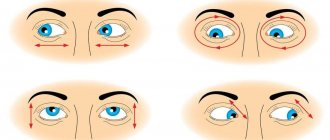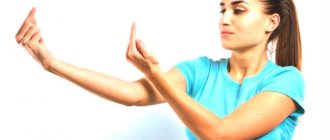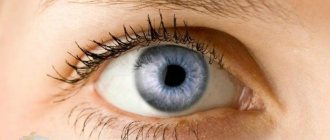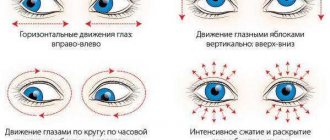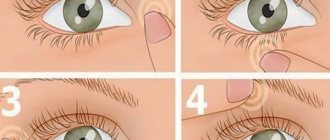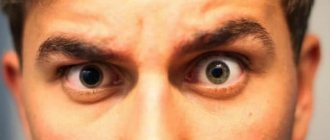The problem of decreased visual acuity in the population is one of the main problems in medicine today. Experts say that myopia and farsightedness are reaching epidemic proportions. But these diseases can be treated with both conservative and surgical methods. Separately, it is worth considering such a method of restoring vision as eye gymnastics according to Avetisov. This technique has received worldwide recognition. It was originally created to be used for the treatment and prevention of childhood strabismus and myopia. But later it was found that regular exercise helped improve the condition of the visual system.
Rules and features of performing exercises
The set of exercises presented by Avetisov includes simple movements of the eyeballs, which are performed at a slow and medium pace. In order for the time spent on gymnastics to bring success, you must observe some nuances:
- Do not turn your body or head. Only the eyeballs are involved in the work.
- Perform systematically. A single exercise will not achieve a positive outcome.
- Do not drink alcohol or drugs. They negatively affect vision, the result will not be noticeable.
- Perform the exercises slowly, gradually speeding up and increasing the load.
- Start with 4-5 movements, increasing the number to 12 in 1 approach. Do not try to perform all 12 movements at once to avoid discomfort and pain.
The Avetisov method is performed in a comfortable position. On average, the entire complex takes up to 15 minutes.
Accommodation training improves microcirculation, strengthens the extraocular muscles and improves image clarity.
Gymnastics for the eyes according to the method of E.S. Avetisov
Group one (to improve blood circulation and intraocular fluid)
Exercise 1. Close the eyelids of both eyes for 3-5 seconds, then open them for 3-5 seconds; repeat 6-8 times. Exercise 2. Blink both eyes quickly for 10-15 seconds, then repeat the same 3-4 times at intervals of 7-10 seconds. Exercise 3. Close the eyelids of both eyes and use the index finger of the corresponding hand to massage them in a circular motion for one minute. Exercise 4. Close the eyelids of both eyes and with three fingers of the corresponding hand lightly press on the eyeballs through the upper eyelids for 1-3 seconds; repeat 3-4 times. Exercise 5. Press the skin of the corresponding brow ridge with the index fingers of each hand and close your eyes, while your fingers should resist the muscles of the upper eyelids and forehead; repeat 6-8 times.
Group two (to strengthen muscles)
Exercise 1. Slowly move your gaze from the floor to the ceiling and back, without changing the position of your head; repeat 8-12 times. Exercise 2. Slowly move your gaze to the right, left and back; repeat 8-10 times. Exercise 3. Slowly move your gaze to the right-up, then to the left-down and back, after that move your gaze along another diagonal - left-up, right-down and back; and so on - 8-10 times. Exercise 4. Make circular movements with your eyes in one direction, then in the other; repeat 4-6 times.
Group three (to improve accommodation)
In this group, exercises are performed from a standing position. Exercise 1. Look forward with both eyes for 2-3 seconds, then look at the finger of your right hand, placing it in front of your face to the level of your nose at a distance of 25-30 centimeters, and after 3-5 seconds lower your hand; repeat this 10-12 times. Exercise 2. With both eyes, look for 3-5 seconds at the index finger of your left hand, extended in front of your face, then, bending your hand, bring your finger closer to your nose until the finger begins to double; and so on - 6-8 times. Exercise 3. For 3-5 seconds, look with both eyes at the index finger of your outstretched right hand, then cover your left eye with your left palm for 3-5 seconds, and at this time bend and straighten your right hand. Do the same, covering your right eye with your right hand; repeat 6-8 times. Exercise 4. It is called “Mark on glass”. Being 30-35 centimeters from the window glass, attach a round colored mark with a diameter of 3-5 millimeters to it at eye level, then, far from the line of sight passing through the mark, mark an object for visual fixation. Look, without taking off your glasses, with both eyes at this mark for 1-2 seconds, then move your gaze to the intended object for 1-2 seconds, after which you alternately move your gaze to the mark and then to the object. On the first two days - 5 minutes, on the remaining days - 7 minutes. Repeat systematically at intervals of 10-15 days. The exercise can be performed not only with two, but also with one eye 2-3 times a day.
These exercises are very useful in treating myopia in children.
Group 1
Exercises of the first group help increase blood flow in the eyeball area and speed up the circulation of intraocular fluid. All exercises from this group should be performed while sitting.
Exercise 1
It is necessary to close your eyes as much as possible for a few (3-5) seconds, and then open them for the same period of time.
Exercise 2
You should blink your eyes for 10-15 seconds at a fairly fast pace. After this, you should stop and rest for 7-10 seconds. Then repeat the procedure 3-4 more times.
Exercise 3
Use the index finger of your right hand to massage the eye through the closed eyelid. Movements should be circular and not very intense. The duration of the massage is 60 seconds. This exercise helps increase blood flow in the eye area and leads to muscle relaxation.
Exercise 4
Through a closed eyelid, press on the eyeball with three fingers for several (1-3) seconds. Repeat the exercise 3-4 times.
Exercise 5
It is necessary to resist the muscles of the forehead and upper eyelid when trying to close the eye. To do this, use your index finger to press the skin in the area of the brow ridge to the bone structures. The exercise should be repeated 6-8 times.
Features of the technique
Eduard Avetisov always said that the sooner a person begins to take care of his eyes and engage in the prevention of myopia and other diseases, the greater the chance of not having problems with the quality of vision in his life. The gymnastics developed by the scientist are precisely aimed at training the eyes and preventing many diseases.
The emphasis in the technique is on adapting the eyes to various changes that occur as a result of objects moving at different distances. The program is designed to be repeated daily. In general, gymnastics involves several types of eye movements that help train and develop a function called “accommodation.” Avetisov advised doing the exercises during the day, during lunch breaks at work, to relax your eyes and relieve tension.
The sooner a person starts doing such gymnastics, the better. Avetisov especially recommended his method to children - those who performed such tasks from childhood had a minimum of vision problems at an older age. However, gymnastics is also suitable for adults, as well as for lovers of reading and those who work a lot at the computer.
Advantages of Avetisov gymnastics:
- short duration of exercises - it is enough to spend only 15-20 minutes a day on eye training;
- good prevention of eye diseases;
- the ability to cope with a number of pathologies without drug treatment;
- the ability to perform gymnastics anywhere - at home, at work, on the street, in transport, etc.;
- ease of performing exercises - you do not need to have special skills or any specialized equipment;
- This type of gymnastics improves concentration.
Valeria, 24 years old: “My daughter and I have been doing Avetisov gymnastics since she was 4 years old, when the doctor first told us that her visual acuity had dropped a little. Her ophthalmologist advised us so that her pathology would not progress in the future. For a child, this is a kind of game - she likes to sit down with me and do these simple exercises. It’s both fun and useful. The baby doesn’t complain about her eyes.”
What positive effect does this program have?
If you perform the prescribed actions correctly and regularly, you can achieve the following results:
| 1 | Improving blood circulation in the vessels of the retina and fluid circulation inside the eye |
| 2 | Remembering correct eye movements |
| 3 | Improved accommodation |
| 4 | Reducing computer eye fatigue |
| 5 | General strengthening of all eye muscles |
The program developed by Avetisov is divided into 3 groups. Each group contains special exercises that are aimed at certain aspects of improving eye function.
All the exercises are simple and easy to perform at home, but you will need to concentrate hard to perform them accurately.
If a person has just started, then 3-5 repetitions for each action are enough, and when the level of training has become higher, then this number can be increased, but to a maximum of 12 repetitions.
Group 2
The second group of exercises is aimed at strengthening the extraocular muscles. You should not move your head while performing them. The starting position is also sitting.
Exercise 1
Slowly raise your gaze to the ceiling and then back to the floor. It is advisable to repeat the exercise 8-12 times.
Exercise 2
It is also necessary to slowly move your gaze in the horizontal plane, while the focus point moves to the left and then to the right. Repeat the exercise 8-10 times.
Exercise 3
At the same slow pace, you should move the focus point diagonally (left-up, right-down and vice versa). Repeat this exercise 8-10 times.
Exercise 4
Make circular movements with your eyes counterclockwise or clockwise. Repeat the exercise 4-6 times.
↑ Preface
Thanks to the care of the Communist Party of the Soviet Union and the Soviet government, socio-economic and medical measures to protect the health of children are constantly being carried out in our country in an ever-increasing volume. In solving this problem, an important place belongs to the struggle to preserve full vision
, the role of which in human cognitive and labor activity is exceptionally great.
It should be noted with satisfaction that the volume of ophthalmological care for children is continuously increasing and its quality is improving. pediatric ophthalmologists is growing
.
The network of children's eye offices
and hospitals is expanding, the number of beds in them is increasing, and their technical equipment is improving.
New progressive forms of providing ophthalmological care to children are becoming widespread - treatment of children with visual impairments
in specialized preschool children's institutions and sanatorium-type pioneer camps.
Work is increasingly being carried out to prevent visual disorders and eye diseases in children.
, their early detection and treatment. Every year, an increasing number of children, including those with normal vision, undergo dispensary examination.
The scientific development of issues in pediatric ophthalmology and the introduction of scientific achievements into practice are carried out on a large scale. Valuable data were obtained on the age-related characteristics of the organ of vision in children under normal conditions and pathology. Based on an in-depth study of the mechanism of origin of myopia
real ways to prevent it, prevent the progression of the disease and the development of complications have been identified.
A fundamentally new system of complex treatment of strabismus
.
Effective methods for treating congenital glaucoma
and
congenital cataracts
using microsurgical techniques.
The etiological diagnosis of inflammatory diseases of the organ of vision in children has significantly improved and the effectiveness of their treatment has increased. Methods for microsurgical and therapeutic treatment of eye injuries
and their consequences in children have been improved, as well as methods for diagnosing and complex treatment of retinoblastomas in children.
In connection with the above, there is a need to publish a manual on pediatric ophthalmology, which would summarize scientific achievements and best practical experience in this field of medicine. This is the first time such a guide has been published in our country.
The manual is based on the results of scientific research on the problem of pediatric ophthalmology
carried out in the Department of Vision Protection for Children and Adolescents, in the Department of Pathology of the Visual Organ in Children of the Moscow Research Institute of Eye Diseases named after. Helmholtz and at the Department of Eye Diseases of the Pediatric Faculty of the II Moscow Order of Lenin State Medical Institute named after. N.I. Pirogova.
The authors will gratefully accept useful advice and suggestions from readers.
Pictures (screenshots) of the book
Eye exercises according to Avetisov for children
The child’s body, in particular its visual system, actively develops in the first ten years. During this period, the eyes are often exposed to a number of negative factors, which may include reading books, TV, computer, various injuries, and so on.
In order for your eyes to cope with all these loads, and the risk of various vision problems is minimized, it is recommended to pay attention to the following tips:
- A child needs physical activity - in childhood it helps to normalize eye performance. Running, jumping, walking and outdoor games are very useful.
- It is important to monitor the correct posture of the baby. If it is curved, then the proper blood supply to the brain is disrupted, which has a negative effect on vision.
- Spending a long time in front of a computer or TV is highly undesirable. Let your baby take breaks. You need to look at the screen exclusively directly. In addition, it is important that the room has good lighting, since in an unlit room the child’s eyes will systematically change focus and become very strained.
Proper exercises help improve vision, relieve tension, and prevent deterioration in eye function and eye diseases. Regular exercise helps improve the condition of the eye muscles and strengthens them.
The set of exercises for children's eyes that Avetisov advises includes the following exercises:
- Inhale, look between the eyebrows for a couple of seconds, and exhale, return to the original position.
- After inhaling, look at the tip of your nose, then also return to your original position.
- As you inhale, you need to look to the right, and as you exhale, return your eyes to their original position. The same thing happens when looking to the left.
- As you inhale, you need to look at the upper left corner (about 45 degrees from the vertical), and then back. Then look to the lower right corner and also return to the starting position. Repeat the same from the right corner, as if you are mentally trying to draw the letter X.
- Inhale, smoothly draw a semicircle with your eyes, first to the left, then to the right. Start at the bottom and stop at the top.
Such exercises help not only improve vision, but also relieve fatigue and tension in the visual organs. It is recommended to devote 15-20 minutes to exercise daily, and then the results will not be long in coming.
Gymnastics in pictures, as well as videos on this topic, will help you better understand how and what exercises to perform according to Avetisov.
Useful video
Why exercises are not useful for everyone and how accommodation disorders are related to the work of the internal muscles and changes in the lens:
Author's rating
Author of the article
Alexandrova O.M.
Articles written
2029
about the author
Was the article helpful?
Rate the material on a five-point scale!
( 1 ratings, average: 5.00 out of 5)
If you have any questions or want to share your opinion or experience, write a comment below.

